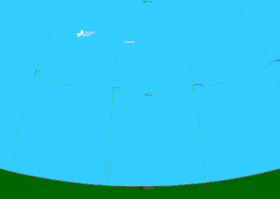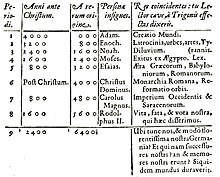Great conjunction

The four Galilean moons : on the left above Jupiter the moons Callisto , Ganymede and Europa , on the right below in close proximity to Jupiter the moon Io .

In astronomy, a major conjunction is the conjunction (approach or contact in the starry sky , seen from Earth) between the planets Jupiter and Saturn . This phenomenon occurs roughly every 20 years, most recently in 2000 and on December 21, 2020.
This periodicity has been observed since ancient times and has inspired astrologers since the High Middle Ages .
Some astronomers and historians suspect that the star of Bethlehem at the time of Jesus' birth had a major conjunction in the years 7 to 6 BC. Could have been.
Astronomical states
periodicity

The orbital times of the two giant planets are around 12 years for Jupiter and 30 years for Saturn (more precise dates are 11.86 and 29.46 years). Therefore the two planets come together again in the sky about 20 years after a conjunction. The constellation in which this apparent encounter takes place shifts each time over around a third of the starry sky - i.e. over around four signs of the zodiac . More precise calculations show an average period of 19.86 years and an angle of 117 ° between two consecutive major conjunctions. Since the two orbits are almost exactly in a ratio of 2: 5, the major conjunction occurs every 60 years at an almost similar point in the starry sky: Jupiter then made 5 orbits, Saturn, however, 2.
Greatest conjunction
When Jupiter and Saturn are close to their opposition at the same time , this movement overlaps with the two annual planetary loops . Then they wander back on the sky map before moving forward again. In any case, Jupiter is moving faster than Saturn. It can happen that three encounters take place in just under a year; the phenomenon is called the Greatest Conjunction . Their occurrence is very rare and has no periodicity. The last time the Greatest conjunction occurred in 1940-1941 and 1981. The next Greatest conjunction will not take place again until 2238–2239.
List of major conjunctions between 1800 and 2100
Since there are two celestial coordinate systems, the data of conjunctions can be defined in two different ways, depending on whether you are looking at the equatorial or ecliptical coordinates. The upper planets Jupiter and Saturn move slowly on the sky map near the ecliptic and the direction of these movements remains almost completely parallel to this line. The angular distance between the two planets is minimal with an ecliptical conjunction. The following table shows the dates in ecliptical length of all conjunctions of the planets Jupiter and Saturn from 1800 to 2100:
| date | Time in WZ |
Angular distance from Jupiter to Saturn |
Elongation of Saturn from the sun |
Zodiac signs |
|---|---|---|---|---|
| July 17, 1802 | 22:57:00 | 39 ′ South | 40.6 ° East | Virgin |
| June 19, 1821 | 16:56:57 | 1 ° 10 ′ North | 63.3 ° West | Aries |
| January 26, 1842 | 06:16:53 | 32 ′ South | 27.1 ° West | Capricorn |
| October 21, 1861 | 12:27:02 | 48 ′ south | 39.7 ° West | Virgin |
| April 18, 1881 | 13:35:59 | 1 ° 13 ′ North | 3.1 ° East | bull |
| November 28, 1901 | 16:37:33 | 26 ′ south | 38.2 ° East | Capricorn |
| September 10, 1921 | 04:13:03 | 57 ′ south | 9.7 ° East | Virgin |
| August 8, 1940 | 01:13:20 | 1 ° 11 ′ North | 90.9 ° West | bull |
| October 20, 1940 | 04:42:14 | 1 ° 14 ′ North | 164.0 ° West | bull |
| February 15, 1941 | 06:36:25 | 1 ° 17 ′ North | 72.9 ° East | bull |
| 19th February 1961 | 00:07:18 | 14 ′ south | 34.9 ° West | Capricorn |
| December 31, 1980 | 21:17:24 | 1 ° 03 ′ south | 90.9 ° West | Libra |
| March 4th 1981 | 19:14:36 | 1 ° 03 ′ south | 155.9 ° West | Libra |
| July 24, 1981 | 04:13:35 | 1 ° 06 ′ south | 63.8 ° East | Libra |
| May 28, 2000 | 15:56:27 | 1 ° 09 ′ North | 14.9 ° West | bull |
| December 21, 2020 | 18:37:31 | 6 ′ south | 30.1 ° East | Aquarius |
| October 31, 2040 | 12:02:47 | 1 ° 08 ′ south | 20.8 ° West | Libra |
| April 7, 2060 | 22:36:24 | 1 ° 07 ′ North | 41.9 ° East | Twins |
| March 15, 2080 | 01:49:55 | 6 ′ North | 43.5 ° West | Capricorn |
| September 18, 2100 | 22:50:40 | 1 ° 13 ′ South | 29.4 ° East | Libra |
Astrology and history

The astrological doctrine of the twofold periodicity of the major conjunctions was spread in Europe through the books of the Persian astronomer Albumasar , especially after they were printed. However, his fatalistic philosophy was controversial in the Christian church.
In astrology the twelve signs of the zodiac are associated with the four-element doctrine ; so each element corresponds to three signs: fire with Aries, Leo and Sagittarius, earth with Taurus, Virgo and Capricorn, air with Gemini, Libra and Aquarius, water with Cancer, Scorpio and Pisces. So each element forms a triangle or trine on the zodiac. For around 200 years, all major conjunctions take place gradually in the three signs of the same element. But since a slow lag arises, after 10 encounters they come to the trine of the next element, and the cycle does not start again until after about 800 years.
Astrologers are convinced of a connection between heavenly phenomena and earthly events. The completion of an entire cycle of trigons was seen as the due date for important events such as the creation of empires or the coming of a Messiah . Johannes Kepler , for example, divided human history into periods of 800 years. With his heliocentric view, he reduced the length of a cycle to 805 years, while previous astronomers advocated 960 years. Mention of the trigons and major conjunctions can also be found in the works of Tycho Brahe , Dante or Shakespeare .
See also
Literature and web links
- Rüdiger Plantiko: Conjunctions of the outer planets from −1500 to 2500. Astrological materials, December 2007.
- Jean Meeus : Les conjonctions triples Jupiter-Saturne . In: Astronomy. Volume 94, pp. 27-36 (French; online ).
- Johannes Kepler: De stella nova in pede serpentarii. 1606 (Latin; full text in Google Book Search).
- Johannes Kepler: Discurs of the Great Conjunction or gathering Saturni and Jovis in the little sign of Leo. Nuremberg 1623.
Individual evidence
- ↑ Burkard Steinücken: The Star of Bethlehem - How Far Can Serious Astronomical Interpretation Go? Westfälische Volkssternwarte and Planetarium Recklinghausen , March 26, 2003, accessed on December 23, 2017 (PDF; 1.8 MB).
- ↑ Johannes Kepler: De stella nova in pede serpentarii. 1606.
- ↑ a b Jean Meeus : Les conjonctions triples Jupiter-Saturne. In: Astronomy. Volume 94, pp. 27-36 ( online ).
- ↑ A table of the dates of the major conjunctions in right ascension is also available on Wikipedia.
- ^ Albumasar: De magnis conjunctionibus et annorum revolutionibus ac eorum profectionibus. Printed in Augsburg in 1489 and in Venice in 1515. Ed. K. Yamamoto, Ch. Burnett, Leiden 2000, 2 volumes (text in Arabic and Latin).
- ^ Heinrich von Langenstein: Tractatus contra astrologos conjunctionistas de eventibus futurorum (1373). Studies on the astrological writings of Heinrich von Langenstein, Leipzig / Berlin 1933, pp. 139–206.
- ↑ Johannes Kepler: De stella nova in pede serpentarii. 1606.
- ↑ Kennerly M. Woody: Dante and the Doctrine of the Great Conjunctions. Dante Studies, with the Annual Report of the Dante Society, No. 95 (1977), pp. 119-134.
- ↑ Margaret Aston: The Fiery Trigon Conjunction: An Elizabethan Astrological Prediction. Isis, Vol. 61, No. 2 (Sommer, 1970), pp. 158-187.
